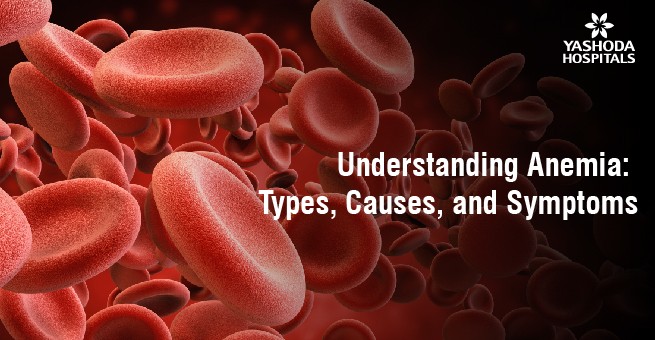
Understanding Anemia: Types, Causes, and Symptoms
Anemia is a medical condition identified by a deficiency in the number or quality of red blood cells, causing a reduced capacity of the blood to carry oxygen to the body's various tissues. It is a common disorder that can affect people of all ages and backgrounds.
In this edition, we will explore the different types of anemia, their causes, and the symptoms associated with this condition.
Types of Anemia
- Iron-deficiency anemia: This is the most common type of anemia that occurs when there is a lack of iron in the body. Iron is necessary for the production of hemoglobin, a protein present in red blood cells that carries oxygen. Inadequate iron intake, blood loss (through menstruation or gastrointestinal bleeding), or poor absorption of iron in the body can lead to iron-deficiency anemia.
- Vitamin deficiency anemia: This anemia is caused by a deficiency of certain vitamins in our bodies that are necessary for the production of healthy red blood cells. Vitamin B12 and folate are essential for red blood cell formation. A lack of these vitamins, often due to poor dietary intake or malabsorption can result in vitamin deficiency anemia.
- Hemolytic anemia: Hemolytic anemia occurs when red blood cells get destroyed or broken down faster than they are produced. This can be caused by a variety of factors, including autoimmune disorders, infections, certain medications, or genetic conditions like sickle cell disease.
- Aplastic anemia: Aplastic anemia is a rare but serious type of anemia in which the bone marrow fails to produce the required amount of red blood cells, white blood cells, and platelets. It can be acquired or inherited and may result from autoimmune diseases, viral infections, exposure to certain toxins, or certain medications as well.
- Hemoglobinopathies: Hemoglobinopathies are genetic disorders that affect the structure or production of hemoglobin, leading to various types of anemia like sickle cell anemia, thalassemia, and hemoglobin C disease. These can cause chronic anemia with significant health implications.
Causes of Anemia
The causes of anemia can vary depending on the type, but some common factors include:
- Poor dietary intake: Inadequate consumption of iron-rich foods, such as red meat, leafy greens, and legumes, can lead to iron-deficiency anemia. Similarly, a lack of foods rich in vitamin B12 and folate, such as meat, dairy products, and leafy vegetables, can cause vitamin deficiency anemia.
- Chronic diseases: Certain chronic conditions, such as kidney disease, cancer, and autoimmune disorders, can interfere with the body's ability to produce red blood cells, leading to anemia.
- Blood loss: Excessive blood loss leads to anemia. This can occur due to heavy menstrual periods in women, gastrointestinal bleeding from ulcers or tumours, or trauma injuries.
- Infections: Infections like malaria, HIV/AIDS, and tuberculosis can cause anemia by affecting the production or lifespan of red blood cells.
- Genetic factors: Inherited disorders like sickle cell disease, thalassemia, and other hemoglobinopathies can lead to chronic anemia.
Symptoms of Anemia
The symptoms of anemia can vary depending on its severity and underlying cause. However, common signs and symptoms of anemia include:

- Fatigue and weakness: Reduced oxygen-carrying capacity of the blood due to inadequate amount of red blood cells and hemoglobin, can lead to a constant feeling of tiredness and lack of energy.
- Shortness of breath: Anemia can cause a decreased supply of oxygen to the body's tissues, resulting in difficulty breathing, especially during physical exertion.
- Pale skin: Anemic individuals may have a pale or yellowish complexion, as the reduced number of red blood cells affects skin colouration.
- Rapid or irregular heartbeat: Anemia can cause the heart to work harder to compensate for the decreased oxygen-carrying capacity, resulting in a faster or irregular heartbeat.
- Dizziness and lightheadedness: Inadequate oxygen supply to the brain can lead to feelings of dizziness, lightheadedness, or even fainting.
- Cold hands and feet: Reduced blood flow to the extremities can cause a sensation of coldness in the hands and feet.
- Headaches: Anemia can result in frequent headaches or migraines due to the decreased oxygen supply to the brain.
- Brittle nails and hair loss: Anemia can affect the health of nails, making them brittle and prone to breaking. It can also contribute to hair loss or thinning.
It is important to note that these symptoms can also be associated with other medical conditions, so it is essential to consult your doctor for an accurate diagnosis.
Let us take a look at our doctor’s talk, testimonials, and blogs.
Iron Deficiency Anaemia in Pregnancy | Yashoda Hospitals Hyderabad
Aplastic Anemia - BMT | Yashoda Hospitals Hyderabad
Are You Suffering From Any of the Above Symptoms?
Appropriate treatment is necessary, as it ensures that your life goes on as normally as possible.
And given the potentially life-changing consequences of treatment and surgery, it is always critical to seek a second opinion from a medical professional. Get a free expert second opinion from Yashoda Hospitals.
Share your thoughts in the comments section below and let us know what you'd like to see in our next week's newsletter.
If you liked it, please share this edition with your friends and family.
Sales Associate at American Airlines
10moThanks for sharing